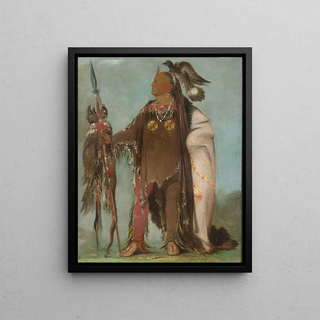Art print | Pa-rs-ka-ro-pa Two Crows, a gang leader - George Catlin


View from behind

Frame (optional)
In the fascinating world of Native American art, the artwork "Pa-rs-ka-ro-pa Two Crows, un chef de bande" by George Catlin stands out for its authenticity and narrative depth. Catlin, as a portraitist of Native American tribes, captured the very essence of his subjects, revealing their stories, struggles, and culture through delicate brushstrokes. This art print invites us to immerse ourselves in a world where every detail, every color, tells a story, a heritage. Contemplating this piece, the viewer is transported to the heart of the American plains, face to face with a chief whose intense gaze seems to convey all the wisdom and strength of his people.
Style and uniqueness of the work
Catlin's style is characterized by a realistic approach, but also by a poetic sensitivity that transcends simple portraiture. In "Pa-rs-ka-ro-pa Two Crows," the depiction of the chief is imbued with majestic dignity. The vibrant colors and meticulous details of the traditional clothing, adorned with feathers and symbolic motifs, testify to a deep respect for Native American culture. Catlin does not merely depict an image; he creates an atmosphere, a connection between the subject and the observer. The facial features of Two Crows, marked by time and experience, are rendered with such precision that they almost seem alive. This art print is a celebration of identity and resilience, an invitation to rediscover a heritage often overlooked.
The artist and his influence
George Catlin, born in 1796, was one of the first artists to dedicate his career to documenting Native American cultures. Traveling across the United States, he created numerous works that today serve as invaluable testimonies of the tribes' lives and traditions. His artistic approach was deeply committed, aiming to raise awareness among the public about the often-overlooked realities of these populations. Catlin not only left an artistic legacy but also played a crucial role in preserving the history of the Native Americans at a time when their existence was threatened.

Matte finish

View from behind

Frame (optional)
In the fascinating world of Native American art, the artwork "Pa-rs-ka-ro-pa Two Crows, un chef de bande" by George Catlin stands out for its authenticity and narrative depth. Catlin, as a portraitist of Native American tribes, captured the very essence of his subjects, revealing their stories, struggles, and culture through delicate brushstrokes. This art print invites us to immerse ourselves in a world where every detail, every color, tells a story, a heritage. Contemplating this piece, the viewer is transported to the heart of the American plains, face to face with a chief whose intense gaze seems to convey all the wisdom and strength of his people.
Style and uniqueness of the work
Catlin's style is characterized by a realistic approach, but also by a poetic sensitivity that transcends simple portraiture. In "Pa-rs-ka-ro-pa Two Crows," the depiction of the chief is imbued with majestic dignity. The vibrant colors and meticulous details of the traditional clothing, adorned with feathers and symbolic motifs, testify to a deep respect for Native American culture. Catlin does not merely depict an image; he creates an atmosphere, a connection between the subject and the observer. The facial features of Two Crows, marked by time and experience, are rendered with such precision that they almost seem alive. This art print is a celebration of identity and resilience, an invitation to rediscover a heritage often overlooked.
The artist and his influence
George Catlin, born in 1796, was one of the first artists to dedicate his career to documenting Native American cultures. Traveling across the United States, he created numerous works that today serve as invaluable testimonies of the tribes' lives and traditions. His artistic approach was deeply committed, aiming to raise awareness among the public about the often-overlooked realities of these populations. Catlin not only left an artistic legacy but also played a crucial role in preserving the history of the Native Americans at a time when their existence was threatened.






